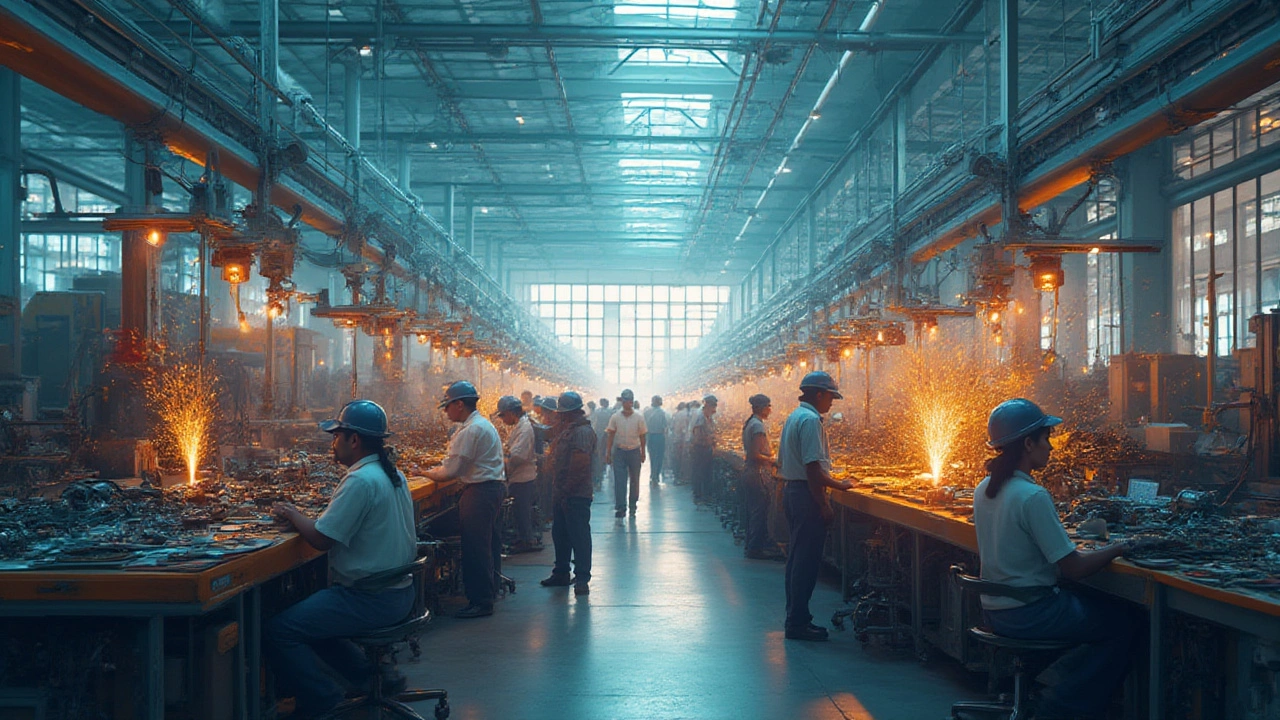Imagine a city without factories. The streets would feel emptier, and shops wouldn’t see nearly as much action. That’s not an exaggeration—there’s something magnetic about manufacturing, pulling so many pieces of our daily lives together. It's more than just assembly lines and smoke stacks. Behind every gadget, car, and cereal box, there’s a web that connects workers, businesses, and even your local coffee shop. Whether you’re a fan of classic American muscle cars or prefer your phone made closer to home, manufacturing has its fingerprints all over your world. But does it really move the economic needle as much as people say? Let’s get behind the numbers and stories to see what’s really going on beneath the hard hats and conveyor belts.
The Backbone Effect: How Manufacturing Fuels Economic Growth
Think of manufacturing as the beating heart inside a country’s economy. It doesn’t just make stuff—it triggers a chain reaction. When a factory starts cranking out products, it needs raw materials, transportation, machines, energy, and more. Every dollar factories spend on these sparks spending in other industries. Take steel production. When a steel mill in Pennsylvania rolls out the good stuff, it creates jobs—not just for steelworkers, but for truckers, mining companies, tech suppliers, and café owners who serve lunch to all those workers. According to the U.S. Bureau of Economic Analysis, every $1 spent in manufacturing adds another $2.60 to the economy, rippling out into service and support sectors.
There’s also a multiplier effect with manufacturing jobs themselves. One factory worker’s paycheck doesn’t just pay rent. Some of it buys groceries, covers medical bills, or gets spent at the movies. This puts money in the hands of even more people, creating a rising tide for the community. It kind of explains why areas with busy factories often look livelier, with more bustling businesses and lively neighborhoods than towns without manufacturing.
Now, scale up from your local town to a whole country. Countries with strong manufacturing sectors—think Germany, China, or South Korea—tend to boast more steady economic growth. Advanced economies often rely on manufacturing to anchor productivity, export revenue, and incomes. In fact, a recent 2023 World Bank report noted that manufacturing exports remain the leading source of revenue for over half the world’s fastest-growing economies. These aren’t just numbers—they reflect how bread gets on tables, how schools get funded, and how innovation finds its next laboratory.
Let’s not sugarcoat it, though. Manufacturing can be risky if a country leans too heavily on it, especially when the world market shakes. During the COVID-19 pandemic, for example, sudden shutdowns of factories led to global supply shortages, price hikes, and even more stress for everyday folks. But most economists agree: a healthy manufacturing base still acts as a shield against downturns—offering a middle ground between “just-in-case” safety and “just-in-time” efficiency. It gives countries leverage—not just in goods, but on the diplomatic stage too.
| Country | Manufacturing % of GDP (2024) | Manufacturing Jobs (Millions) |
|---|---|---|
| Germany | 20% | 8 |
| United States | 11% | 12 |
| China | 26% | 112 |
| South Korea | 27% | 4 |
Take those numbers in for a second. Countries heavily invested in manufacturing aren’t just making stuff—they’re employing millions, training skilled workers, and sending out waves of economic energy.
Job Creation and Wages: More Than Just Paychecks
Maybe you’ve heard the phrase, “factory jobs are dead.” Not quite. Sure, some machines now do what humans used to, but manufacturing jobs still pack a punch for regular folks trying to build a good life. The U.S. Bureau of Labor Statistics reports that, as of mid-2024, manufacturing employs almost 12 million Americans—most of them pulling in better-than-average wages for their skill set. Manufacturing roles often offer stability and solid benefits that food service or retail can’t always match.
But it’s not just about the numbers on a paycheck. Manufacturing jobs kick open doors for upward mobility. Many require some training—the kind you get from technical colleges or apprenticeships, not expensive four-year degrees. That helps people move quickly from entry-level work straight into the middle class. Take a look at some classic American stories: people who started as machinists, welders, or technicians, and worked their way up to supervisory positions or even plant management, often without a fancy diploma.
When factories expand or new ones open, it’s not just workers who benefit. Local economies see a boost too. Supporting industries spring up around them: toolmakers, maintenance contractors, local restaurants, and schools all see more action. Think of Detroit during its auto boom years—sure, there were setbacks and changes, but when cars rolled off assembly lines, the whole city felt it. When factories modernized and invested in automation, they also needed engineers, programmers, and system analysts—adding a new layer of skilled jobs.
Critics sometimes raise a valid point: what about job losses when manufacturing goes high-tech or crosses borders? Factory work has become more specialized, and, yes, automation and offshoring have trimmed old-school assembly jobs. According to a 2023 MIT study, automation caused most recent job losses—outpacing offshoring by three to one. Countries that invested in retraining and helped communities innovate rode out the bumps better, with workers learning new skills instead of being left behind.
For anyone breaking into the workforce, or looking for a second chance, manufacturing offers more options than you might think. Programs for veterans, people without college degrees, or folks switching careers help smooth the way into this field. Not only do you get to work with cutting-edge tools, but you also find real chances to grow—both on the shop floor and beyond.

Innovation, Exports, and National Security
Here’s where manufacturing goes turbo: inventiveness. Walk into any busy production plant and you’ll see it firsthand. Robotics, AI, green tech, 3D printing—these tools are changing how we make stuff, from sneakers to satellites. According to the National Association of Manufacturers, over 60% of all private-sector R&D spending in America in 2023 happened in manufacturing, not software or finance.
Innovation isn’t just for big shots, either. Small and medium-sized factories tinker and improve constantly, shaving seconds off processes, reducing waste, and designing better products. Some of the most famous success stories come from teams huddled in small-town workshops, coming up with the next big thing. Invite any old-timer to talk about life on the assembly line, and you’ll hear stories about “the day we changed the way we did things forever.”
Exports are another piece of the puzzle. Products that leave the country—everything from jet engines to farm equipment—bring in cash, create jobs, and help pay for imports like phones or souvenirs from abroad. The U.S. Department of Commerce showed that in 2024, manufactured goods made up 70% of total U.S. exports, pumping about $1.3 trillion into the economy. That’s a lot of cheddar.
Now picture a world where a country lets its factories vanish. It gets riskier to get crucial items—medical gear, electronics, defense equipment—from other nations. Think back to the wild days of 2020, when personal protective gear was suddenly in short supply. Countries with their own PPE manufacturing lines fared better. A strong manufacturing base means a country can stand on its own in a pinch, slap together what its people need, and keep some strategic secrets safe from rivals.
- Tip: If you’re job hunting or want job security, look at fields connected to manufacturing innovation—robotics, supply chain tech, sustainability, and quality management are always thirsty for new talent.
- Manufacturing is usually the first to recover after a recession—so if you notice local hiring picking up, other sectors may soon follow.
- When picking companies to invest in, weigh ones that are leading the charge on tech in manufacturing—a little research on patents and R&D expense can reveal a lot.
Balancing Benefits and Trade-Offs
It’d be easy to sit here and pretend manufacturing is all blue jeans and pay raises, but let’s talk real. Every upside comes with its price. Factories can create pollution, contribute to climate issues, and sometimes suffer strikes or tough layoffs. The factory boom of the mid-20th century made American cities rich and buzzing. But pollution from steel, chemicals, and coal plants darkened skies and put people at risk—research out of Pittsburgh and Chicago in the 1970s showed asthma and heart disease rates tied back to old factories.
This isn’t the same old story, though. Over the last few decades, governments and manufacturers got smarter. Cleaner energy, tighter controls, smart recycling—all these have made a difference. In Germany, for example, manufacturing grew by 35% since the late 90s, but pollution levels dropped sharply thanks to new tech and strict rules. Today’s smart factories can often run with far less waste and energy, while workers wear sensors that flag safety risks before injuries happen.
Then there’s the question of “reshoring”—bringing factories back home. It can mean higher costs, but it also boosts jobs, quality, and security. Apple, for one, brought some production of Mac computers to Texas. Car makers like Ford and Toyota are investing heavily in American and European plants—particularly electric vehicles and batteries—instead of relying so much on overseas suppliers. This trend isn’t just hype; it’s happening because customers care about origin, governments want more local jobs, and unpredictable politics can mess with far-off supply lines.
So, should countries bet big on manufacturing or spread their chips? Smart bets combine manufacturing with flexible retraining programs, help small businesses plug into supply chains, and encourage cleaner production. Countries where workers, managers, and communities talk often and openly adapt faster and weather storms better.
At the end of the day, manufacturing puts money in pockets, food on tables, and new inventions in our lives. Is it good for the economy? You can see it in every job created, every dollar bounced through the system, and every spark of innovation on a factory floor. That’s not just talk—it’s how our world works, every single day.
